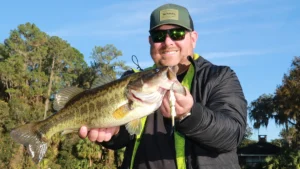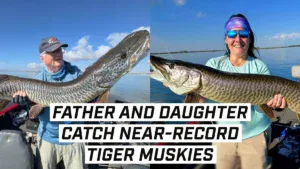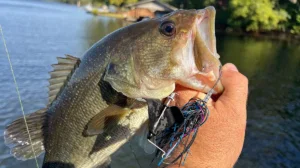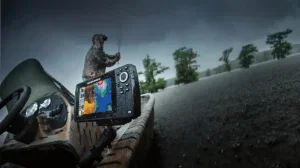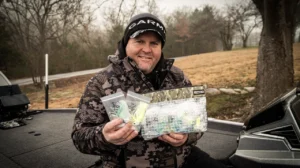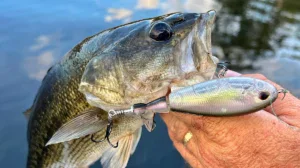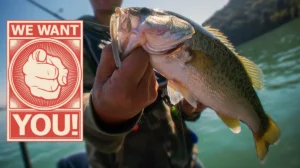It’s no secret that forward-facing sonar is now firmly a part of the fishing landscape. Some people agree with its use and run it on their boats, others can’t stand the sight of it and call it cheating. Whether you like it or not, you can’t argue that it uncovers a lot of knowledge and information from beneath the water’s surface that you never knew was there. More importantly, it’s all in real time.
As of today, there are hundreds of different ways to mount FFS transducers to your boat, but there are only two main ways of viewing it on your screen: forward and perspective viewing. Both have their ideal use case, but is one better than the other?
Some anglers say yes, others no, but finding what’s best for you will determine which setting you use more often. Let’s discuss what each setting is and how to use them.
Forward View: The True GOAT of Live-View Sonar

When it comes down to the realm of live sonar technology, most anglers use the forward view most often. Whether they’re looking to find fish on structure, get a better look at what they’re fishing, or just cast a little “minner” out there to catch a bass, it’s the easiest view to interpret, and you can see your bait and fish in real time.
Often, out on the water, forward view can be the deciding factor in whether you get bites or not. It shows a fish’s true reactions, which is invaluable for every type of fishing. When you see fish on your screen following your bait and not committing to it, you know it’s time to switch something up. You can see their every little reaction and every movement.
Suspended Fish
Forward view is easily the most popular for casting a bait and monitoring its every movement. “Shaking a minner” means essentially casting a jig head with a soft bodied fluke style minnow bait at suspending fish.
Before this technology, suspended fish were always thought of as uncatchable. But now, with FFS, that’s all changed. It’s unlocked a whole new realm of fish.
Perspective View: Getting a Much Better Look at the Bottom

When Humminbird came out with its MEGA 360 Sonar many moons ago, it changed the way we could view structure. Not only could we now see what was in front of the boat, we could also see what was around it in every direction.
It enabled anglers to cast at everything around the boat, but there was one problem. Whenever you moved the boat, you’d have to wait for your view to load on the screen to then make your next cast to be precise. When Garmin entered the game with their Perspective Mode of the LiveScope LVS34 Transducer with the special perspective mount for a trolling motor, it changed the game.
Perspective or “scout mode” depending upon what brand of head unit you have is essentially what Hummingbird created years ago, but added the live real time aspect to it making it a vital tool. You can use it to see different pieces of structure in front of your boat at any given time, allowing you to make multiple different casts. For having multiple anglers in the boat, this is a game changer! This way not every angler is focused on fishing the same exact piece of structure and gives the fish a different look.
Don’t think you can’t see fish on it either. Often, in perspective mode, you can see the shadows and little dots swimming around the screen. You can even see clusters of fish schooled up that you never even knew were there. Perspective mode paints the picture of what we always thought the bottom looked like in our minds, but only so much better.

When To Use Each Mode
The anglers who like getting up in the dirt for largemouth are going to have their sonar set differently than anglers chasing schools of yellow perch for dinner. The way you fish dictates how you’ll set up your sonar.
If you like fishing deep structure, watching your bait on the screen at all times and chasing individual fish, then forward view is what you’ll need. It will allow you to do everything mentioned above and you’ll be able to see fish and their every movement in the water.
It will also allow you to pinpoint exactly where you want your lure to land and watch it from the time that it hits the water till the time it’s back at the boat. With an 18- to 20-degree cone angle on most FFS transducers, this allows for only a small window of the water column and bottom to be seen, so making your casts count is crucial to see it.
If you fish mainly shallower water (less than 20 feet), like seeing what’s around the boat and being able to cast at multiple different objects at a time, then you’ll want to use perspective mode. Your cone angle is increased greatly, giving you a much wider view of the bottom.
When you get into depths greater than 20 feet of water, your images in perspective mode become distorted and unclear due to the increased depth. For shallow water anglers, it works perfect to get the clearest picture of what is around the boat.
Can you use both simultaneously? Absolutely you can! Just make sure that the transducers are adequately spaced on your trolling motor so you can get the highest quality picture on your screen without causing interference.
The Author’s Sonar Setup
Currently, I run a single Garmin LVS34 transducer on the shaft of my Minn Kota Ultrex. The transducer is then set up on a Garmin Perspective View Mount which allows me to easily adjust the mount in any position on the fly while I’m fishing. Whether I’m guiding clients, or fun fishing around my local lakes, I utilize both viewing modes to help put more fish in my boat.
I keep the forward view turned on nearly all the time, mainly because I am your traditional “scoper” and love to see what’s going on with my bait. On some of the Finger Lakes, as well as Lake Erie and Lake Ontario, being able to fish for those suspended fish could cash you a check in those local tournaments or just get my clients an extra fish or two. Whether it’s 5 feet of water for largemouth on shallow rock piles or jigging lake trout in 150 feet, forward view is always a key player on both of my boats for a variety of species.
I only use perspective view when I’m fishing for bass and the water is much shallower. It’s easier to pick out groups of rocks and various hard structures as opposed to constantly scanning around with the trolling motor. Also, when I’m guiding clients, I can have them cast at various targets around the boat and not just in one exact spot.
—
In the end, whatever mode you decide to use, it’s all personal preference and what style you like to fish. If you want to fish deeper, the forward view works best. For shallow water, lean on the perspective view to get a better reading.
Having the option for both on different mounts can be beneficial. You can’t change positions on it when you don’t have the option to change the view. It’s better to have it on an adjustable mount than to have it fixed in one position all the time.




